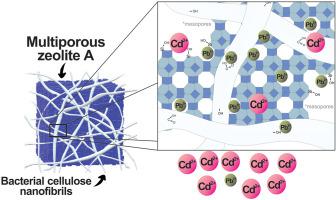Microporous and Mesoporous Materials ( IF 5.2 ) Pub Date : 2020-11-13 , DOI: 10.1016/j.micromeso.2020.110752 Raquel A. Bessa , Antonia Mayza M. França , André Luís S. Pereira , Natália P. Alexandre , Maria Pérez-Page , Stuart M. Holmes , Ronaldo F. Nascimento , Morsyleide F. Rosa , Michael W. Anderson , Adonay R. Loiola

|
A multiporous zeolite A (Ab) was obtained by the addition of the organosilane molecule dimethyl octadecyl [3-(trimethoxysilyl)propyl]ammonium chloride (TPOAC) in the synthesis gel and successfully dispersed in bacterial cellulose forming aerogels for Pb2+ adsorption. Several characterization techniques such as powder X-ray diffraction (PXRD), Fourier-transform infrared spectroscopy (FTIR), scanning electron microscopy (SEM), and N2 adsorption-desorption were employed to investigate physical, chemical, and textural properties of the samples. The resulting material is also compared to the conventional microporous zeolite A and shows a positive interaction between zeolite crystals and cellulose nanofibrils, specially when the mesopores are present in the crystal. Improvements are observed for the multiporous samples in both adsorption and ionic exchange processes. The selectivity for Pb2+ in the presence of Cd2+ is enhanced as a result of improved intraparticle diffusion where there is the insertion of mesopores to the structures. From the kinetic models, the pseudo-second order model fits better to the experimental data suggesting chemisorption as the governing process in adsorption and the mesopores seem to have a remarkable role on it. These multiporous materials facilitate the access of Pb2+ to the zeolite inner pores and therefore present high potential to be used for both Pb2+ adsorptive and analytical devices.
中文翻译:

基于多孔沸石A和细菌纤维素的分级沸石:Pb 2+的有效吸附剂
通过在合成凝胶中添加有机硅烷分子二甲基十八烷基[3-(三甲氧基甲硅烷基)丙基]氯化铵(TPOAC),获得了多孔沸石A(A b),并成功地分散在细菌纤维素形成气凝胶中以吸附Pb 2+。几种表征技术,例如粉末X射线衍射(PXRD),傅立叶变换红外光谱(FTIR),扫描电子显微镜(SEM)和N 2吸附-解吸用于研究样品的物理,化学和纹理特性。还将所得材料与常规的微孔沸石A进行比较,并且显示出沸石晶体与纤维素纳米原纤维之间的正相互作用,特别是当晶体中存在中孔时。在吸附和离子交换过程中都观察到多孔样品的改进。在Cd 2+存在下对Pb 2+的选择性由于中孔向结构的插入而改善了的颗粒内扩散,增强了这种结构。从动力学模型来看,拟二级模型更适合于实验数据,表明化学吸附是吸附过程中的主导过程,中孔似乎在其中起着显著作用。这些多孔材料有利于Pb 2+进入沸石内孔,因此具有很高的潜力,可用于Pb 2+吸附和分析装置。


























 京公网安备 11010802027423号
京公网安备 11010802027423号